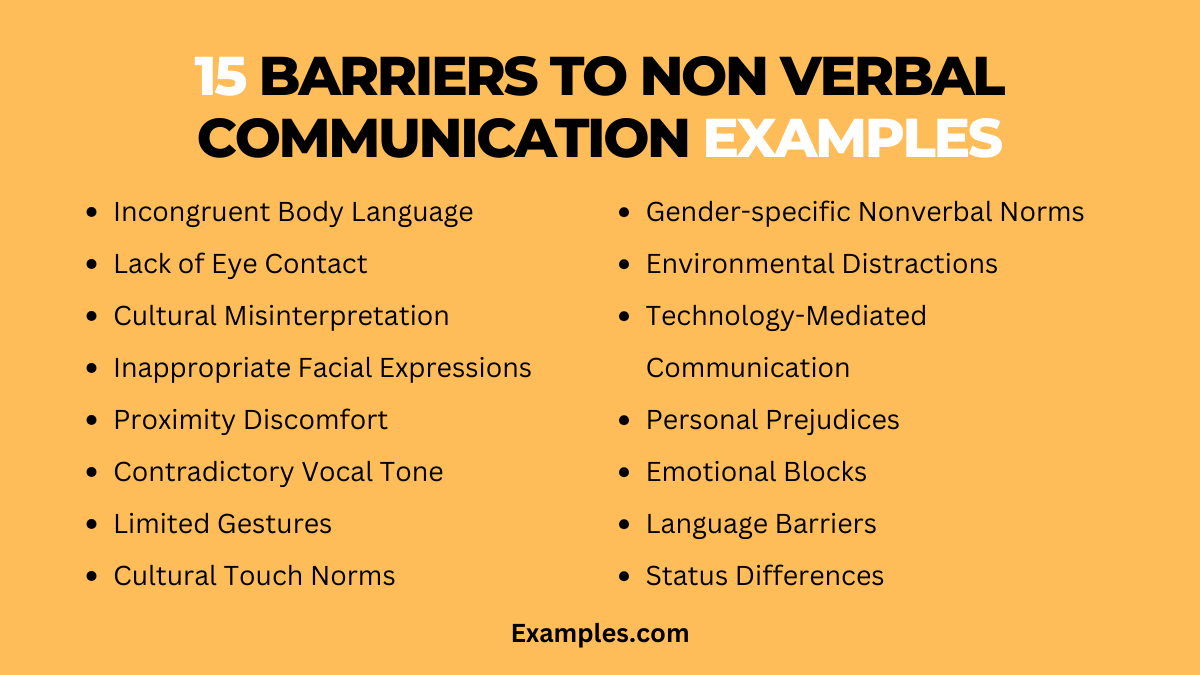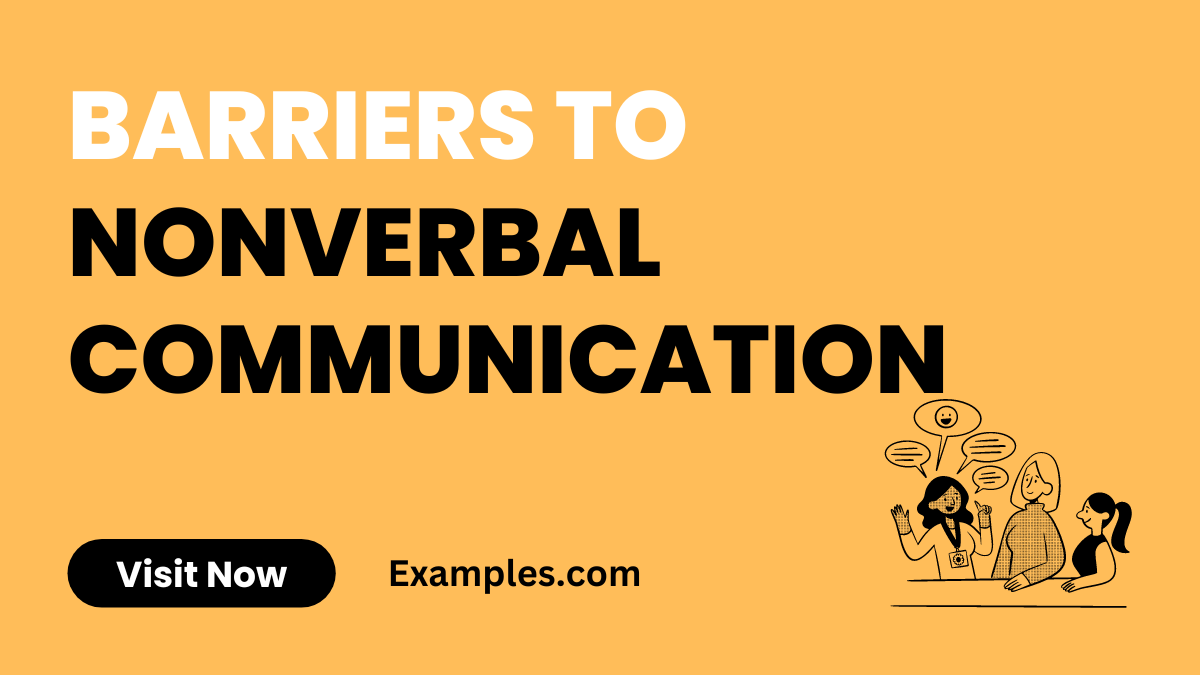14+ Barriers to Nonverbal Communication Examples
Unlock the nuances of effective communication with our comprehensive guide on Barriers to Nonverbal Communication. From cultural intricacies to healthcare contexts, we delve deep into the challenges hindering seamless interactions. This guide not only identifies obstacles but provides vivid Communication Examples, offering actionable insights to enhance your nonverbal communication skills. Join us as we navigate through real-world scenarios, empowering you to overcome barriers and become a proficient communicator. Elevate your communication game with practical tips and relatable examples.
What are the Barriers to Nonverbal Communication

Barriers to nonverbal communication are impediments that obstruct the smooth transmission of messages without the use of words. In simple terms, these are challenges that hinder the effective exchange of information through gestures, body language, and facial expressions. Understanding these barriers is crucial for improving interpersonal connections and communication skills. Let’s explore the clear meaning and definition of these barriers in straightforward English to grasp their significance in enhancing overall communication effectiveness.
15 Barriers to Non Verbal Communication Examples
Explore the intricate web of 15 barriers to nonverbal communication, understanding the nuances that impact effective interactions. From cultural disparities to personal discomfort, each barrier is dissected for a comprehensive grasp. Uncover actionable insights to overcome these hurdles, enhancing your communication prowess and fostering stronger connections.

- Incongruent Body Language: When gestures contradict spoken words, confusion arises.
Example: Saying “I’m fine” with crossed arms signals discomfort. - Lack of Eye Contact: Avoiding eye contact may convey disinterest.
Example: Maintain eye contact during a conversation to express attentiveness. - Cultural Misinterpretation: Different cultures interpret nonverbal cues uniquely.
Example: A nod may signify agreement in one culture but politeness in another. - Inappropriate Facial Expressions: Facial cues convey emotions; mismatched expressions may cause misunderstanding.
Example: Smiling during serious discussions may seem insincere. - Proximity Discomfort: Invasion of personal space can trigger discomfort.
Example: Maintain a comfortable distance during conversations to respect boundaries. - Contradictory Vocal Tone: A mismatch between tone and words creates confusion.
Example: A sarcastic tone while praising may lead to misinterpretation. - Limited Gestures: Restricting gestures may hinder effective communication.
Example: Express enthusiasm through animated gestures for clarity. - Cultural Touch Norms: In some cultures, touch is a sign of warmth, while in others, it may be inappropriate.
Example: Handshakes may be perceived differently in various cultural contexts. - Gender-specific Nonverbal Norms: Societal norms influence gender-specific nonverbal expressions.
Example: Men may avoid prolonged eye contact due to cultural expectations. - Environmental Distractions: Noisy or cluttered environments disrupt nonverbal cues.
Example: Choose quiet spaces for meaningful conversations. - Technology-Mediated Communication: Screens may hinder nonverbal expressions. Example: Use video calls for richer communication than text messages.
- Personal Prejudices: Preconceived notions affect nonverbal interpretation.
Example: Overcoming biases ensures unbiased understanding of cues. - Emotional Blocks: Suppressing emotions hampers authentic nonverbal communication.
Example: Allowing oneself to express emotions fosters genuine connections. - Language Barriers: Misunderstandings arise when language is a barrier.
Example: Simplify language when communicating with non-native speakers. - Status Differences: Varied social statuses may influence nonverbal exchanges.
Example: Adapt communication styles to bridge gaps in status-based interactions.
Barriers to Nonverbal Communication in Healthcare
Explore the intricacies of nonverbal communication within healthcare settings, identifying barriers that impact patient care. From misinterpreted gestures to the influence of medical equipment, understand how overcoming these barriers is crucial for fostering trust and empathy in healthcare communication.
- Mismatched Body Language: Patients may feel uneasy if medical staff display conflicting nonverbal cues.
- Invasion of Personal Space: Maintaining appropriate proximity is vital to respect patients’ comfort and privacy.
- Medical Equipment Distractions: Complex machinery can hinder the clarity of nonverbal signals between healthcare professionals.
- Time Constraints: Rushed interactions limit the establishment of effective nonverbal connections with patients.
- Limited Facial Expressions: Masks may impede the conveyance of emotions, impacting patient understanding.
Barriers to Nonverbal Communication in Different Cultures
Delve into the complexities of nonverbal communication across diverse cultures, recognizing barriers that arise from varying norms. From gestures to personal space expectations, explore how understanding and adapting to cultural differences are essential for successful global interactions.
- Eye Contact Variations: Cultural norms dictate the appropriateness and meaning of eye contact, impacting communication dynamics.
- Gesture Misinterpretations: A gesture accepted in one culture may convey a different message in another, leading to confusion.
- Proxemics Differences: Varied expectations of personal space can create discomfort or misunderstandings in cross-cultural exchanges.
- Facial Expression Norms: The acceptability and interpretation of facial expressions vary widely across cultures.
- Time Perception: Differing cultural approaches to time can influence the pace and understanding of nonverbal cues.
Non-verbal Communication and Barriers to Effective Communication
- Barriers to Non-verbal Communication: Unveiling the Challenges: Identification and exploration of the barriers that impede the seamless flow of non-verbal communication, ranging from cultural differences to personal discomfort.
- Cultural Influences on Non-verbal Communication: Examining how diverse cultural norms shape and influence non-verbal expressions, leading to potential misinterpretations.
- Healthcare Context: Unique Challenges in Non-verbal Communication: Navigating the specific challenges within healthcare settings, where non-verbal communication plays a crucial role in patient care and provider interactions.
- Overcoming Barriers: Practical Strategies and Tips: Providing actionable insights and strategies to overcome barriers, fostering improved non-verbal communication skills in both personal and professional spheres.
- Non-verbal Communication and Technology: Challenges in the Digital Age: Exploring how technology-mediated communication introduces unique challenges to non-verbal expression and providing tips for effective digital communication.
- Interpersonal Communication: Building Connections Beyond Words: Highlighting the role of non-verbal cues in interpersonal communication, emphasizing the importance of non-verbal elements in building rapport.
- Real-life Examples: Illustrating Non-verbal Communication Barriers: Offering vivid examples of non-verbal communication barriers in various contexts, enhancing understanding through practical scenarios.
In conclusion, mastering nonverbal communication is paramount for effective interaction. This guide has unraveled barriers, from cultural nuances to healthcare challenges, offering practical examples and strategies. Navigate the complexities, enhance communication skills, and forge meaningful connections. Embrace the art of nonverbal expression for a richer, more nuanced communication experience in various aspects of life.
14+ Barriers to Nonverbal Communication Examples

Unlock the nuances of effective communication with our comprehensive guide on Barriers to Nonverbal Communication. From cultural intricacies to healthcare contexts, we delve deep into the challenges hindering seamless interactions. This guide not only identifies obstacles but provides vivid Communication Examples, offering actionable insights to enhance your nonverbal communication skills. Join us as we navigate through real-world scenarios, empowering you to overcome barriers and become a proficient communicator. Elevate your communication game with practical tips and relatable examples.
What are the Barriers to Nonverbal Communication

Barriers to nonverbal communication are impediments that obstruct the smooth transmission of messages without the use of words. In simple terms, these are challenges that hinder the effective exchange of information through gestures, body language, and facial expressions. Understanding these barriers is crucial for improving interpersonal connections and communication skills. Let’s explore the clear meaning and definition of these barriers in straightforward English to grasp their significance in enhancing overall communication effectiveness.
15 Barriers to Non Verbal Communication Examples
Explore the intricate web of 15 barriers to nonverbal communication, understanding the nuances that impact effective interactions. From cultural disparities to personal discomfort, each barrier is dissected for a comprehensive grasp. Uncover actionable insights to overcome these hurdles, enhancing your communication prowess and fostering stronger connections.

Incongruent Body Language: When gestures contradict spoken words, confusion arises.
Example: Saying “I’m fine” with crossed arms signals discomfort.Lack of Eye Contact: Avoiding eye contact may convey disinterest.
Example: Maintain eye contact during a conversation to express attentiveness.Cultural Misinterpretation: Different cultures interpret nonverbal cues uniquely.
Example: A nod may signify agreement in one culture but politeness in another.Inappropriate Facial Expressions: Facial cues convey emotions; mismatched expressions may cause misunderstanding.
Example: Smiling during serious discussions may seem insincere.Proximity Discomfort: Invasion of personal space can trigger discomfort.
Example: Maintain a comfortable distance during conversations to respect boundaries.Contradictory Vocal Tone: A mismatch between tone and words creates confusion.
Example: A sarcastic tone while praising may lead to misinterpretation.Limited Gestures: Restricting gestures may hinder effective communication.
Example: Express enthusiasm through animated gestures for clarity.Cultural Touch Norms: In some cultures, touch is a sign of warmth, while in others, it may be inappropriate.
Example: Handshakes may be perceived differently in various cultural contexts.Gender-specific Nonverbal Norms: Societal norms influence gender-specific nonverbal expressions.
Example: Men may avoid prolonged eye contact due to cultural expectations.Environmental Distractions: Noisy or cluttered environments disrupt nonverbal cues.
Example: Choose quiet spaces for meaningful conversations.Technology-Mediated Communication: Screens may hinder nonverbal expressions. Example: Use video calls for richer communication than text messages.
Personal Prejudices: Preconceived notions affect nonverbal interpretation.
Example: Overcoming biases ensures unbiased understanding of cues.Emotional Blocks: Suppressing emotions hampers authentic nonverbal communication.
Example: Allowing oneself to express emotions fosters genuine connections.Language Barriers: Misunderstandings arise when language is a barrier.
Example: Simplify language when communicating with non-native speakers.Status Differences: Varied social statuses may influence nonverbal exchanges.
Example: Adapt communication styles to bridge gaps in status-based interactions.
Barriers to Nonverbal Communication in Healthcare
Explore the intricacies of nonverbal communication within healthcare settings, identifying barriers that impact patient care. From misinterpreted gestures to the influence of medical equipment, understand how overcoming these barriers is crucial for fostering trust and empathy in healthcare communication.
Mismatched Body Language: Patients may feel uneasy if medical staff display conflicting nonverbal cues.
Invasion of Personal Space: Maintaining appropriate proximity is vital to respect patients’ comfort and privacy.
Medical Equipment Distractions: Complex machinery can hinder the clarity of nonverbal signals between healthcare professionals.
Time Constraints: Rushed interactions limit the establishment of effective nonverbal connections with patients.
Limited Facial Expressions: Masks may impede the conveyance of emotions, impacting patient understanding.
Barriers to Nonverbal Communication in Different Cultures
Delve into the complexities of nonverbal communication across diverse cultures, recognizing barriers that arise from varying norms. From gestures to personal space expectations, explore how understanding and adapting to cultural differences are essential for successful global interactions.
Eye Contact Variations: Cultural norms dictate the appropriateness and meaning of eye contact, impacting communication dynamics.
Gesture Misinterpretations: A gesture accepted in one culture may convey a different message in another, leading to confusion.
Proxemics Differences: Varied expectations of personal space can create discomfort or misunderstandings in cross-cultural exchanges.
Facial Expression Norms: The acceptability and interpretation of facial expressions vary widely across cultures.
Time Perception: Differing cultural approaches to time can influence the pace and understanding of nonverbal cues.
Non-verbal Communication and Barriers to Effective Communication
Barriers to Non-verbal Communication: Unveiling the Challenges: Identification and exploration of the barriers that impede the seamless flow of non-verbal communication, ranging from cultural differences to personal discomfort.
Cultural Influences on Non-verbal Communication: Examining how diverse cultural norms shape and influence non-verbal expressions, leading to potential misinterpretations.
Healthcare Context: Unique Challenges in Non-verbal Communication: Navigating the specific challenges within healthcare settings, where non-verbal communication plays a crucial role in patient care and provider interactions.
Overcoming Barriers: Practical Strategies and Tips: Providing actionable insights and strategies to overcome barriers, fostering improved non-verbal communication skills in both personal and professional spheres.
Non-verbal Communication and Technology: Challenges in the Digital Age: Exploring how technology-mediated communication introduces unique challenges to non-verbal expression and providing tips for effective digital communication.
Interpersonal Communication: Building Connections Beyond Words: Highlighting the role of non-verbal cues in interpersonal communication, emphasizing the importance of non-verbal elements in building rapport.
Real-life Examples: Illustrating Non-verbal Communication Barriers: Offering vivid examples of non-verbal communication barriers in various contexts, enhancing understanding through practical scenarios.
In conclusion, mastering nonverbal communication is paramount for effective interaction. This guide has unraveled barriers, from cultural nuances to healthcare challenges, offering practical examples and strategies. Navigate the complexities, enhance communication skills, and forge meaningful connections. Embrace the art of nonverbal expression for a richer, more nuanced communication experience in various aspects of life.


